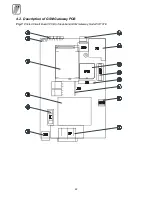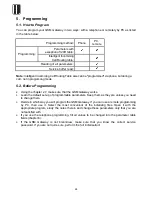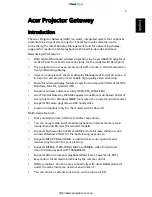
9
2.3. External Antenna Connection
Connect an antenna or an external antenna cable into the FME connector. The antenna
location should have a good GSM signal. The antenna should be in the vertical position. For
antenna and cable parameters refer to the “
Technical Parameters
”.
Tighten an antenna
connector gently by hand; do not use any tools!
2.4. SIM Card Set-up and Installation
2.4.1. Operator / SIM Card Selection
To perform this GSM Gateway function you need a SIM card of a GSM network operator,
using the 900 MHz or 1800 MHz band. The
ATEUS
®
- GSM GATEWAY COMPACT
works with 3V SIM cards. All SIM cards except for the oldest ones meet this condition. If
you are not sure, ask your GSM operator about voltage of your old SIM card. If your SIM
card is new or you are going to buy a new one, you need not worry – your SIM card will
be O.K.
2.4.2. PIN Entering Blocking (Optionally)
The GSM Gateway provides automatic PIN entering by default. You can disable PIN
entering on your SIM card (using a mobile telephone into which you insert your SIM card
for this purpose). If you do disable, you need not worry as to whether there is a PIN code
stored in your GSM Gateway memory. If you enable PIN entering, your GSM Gateway
will require a PIN code after the first power-on and if you enter the PIN correctly, the
GSM Gateway will store it in its memory and enter automatically in the future.
2.4.3. GSM Network Service Setting (Answering Machine, Call Forwarding)
Before the SIM card installation decide whether you will use the
incoming call
forwarding
service provided by GSM networks (call forwarding in the event of busy line,
absence, unavailability...). However, it is more convenient to disable all call forwarding
modes (the GSM operator’s answering machine, e.g.) and use an answering and
recording machine of your own. If you have more GSM Gateways with your PBX, you
can forward calls when one GSM Gateway is busy, etc.
2.4.4. Roaming Parameters Setting (Calling via Foreign GSM Networks)
The GSM Gateway disables roaming by default. It is usually convenient because most
people do not travel with the GSM Gateway and there is a risk with roaming in foreign
countries that, due to a failure in the local GSM network, you might get registered in
another network and pay much more for your calls. To enable roaming and set network
preferences, complete the list of GSM networks to be preferred using your mobile
telephone and then enable roaming while programming the GSM Gateway.
The registration of the GSM Gateway in a foreign GSM network is signalled by a special dial
tone
(refer to the list of tones) and you have to dial numbers including international
prefixes that can be easily barred (refer to
Programming, Call Sorting Table
).
2.4.5. SIM Card Insertion in GSM Gateway
Some gateways have a cover without hole for SIM exchange. In this case, release the
two screws and remove the upper cover face (see Fig. 6). To install the SIM card press
the yellow button on the SIM holder using a suitable tool (e.g. scissor) to make the
drawer slide out. Remove the drawer, insert the SIM card in it, slide the drawer back and
click into position. Then replace the cover face and tighten the screws, if removed. This
protects the GSM Gateway circuits against dust and damage!
Summary of Contents for ATEUS 501101E
Page 2: ......
Page 35: ...33 5 4 11 Remote Supervision Establishing Flow Chart ...
Page 56: ......
Page 57: ... 2002 2N TELEKOMUNIKACE a s Prague DR 972 v 1 33 ...












































